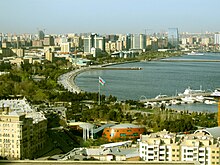Baku Boulevard
| Dənizkənarı Milli Park | |
| National Park | |
 |
|
| Type | Boulevard |
|---|---|
| Maintained by | Mayoralty of Baku |
| Location | Baku, Azerbaijan |
| Construction | |
| Completion | 1909 |
| Inauguration | March 26, 1909 --> |
Baku Boulevard (Azerbaijani: Dənizkənarı Milli Park, also known as National Park) is a promenade established in 1909 which runs parallel to Baku's seafront. Its history goes back more than 100 years, to a time when Baku oil barons built their mansions along the Caspian shore and when the seafront was artificially built up inch by inch.
The park stretches along a south-facing bay on the Caspian Sea. It traditionally starts at Freedom Square continuing west to the Old City and beyond. Since 2012, the Yeni Bulvar (new boulevard) has virtually doubled the length to 3.75 km, extending the promenades to National Flag Square. In 2015 White City Boulevard added a further 2 km to the east of Freedom Square and reports have suggested that eventually the boulevard might be as long as 26 km, including Bibiheybət.
The boulevard was established to connect the oilfields in Bibi Heybet as part of the urban development projects by Municipal Horticultural Commission.
In 1900, the Municipal Horticultural Commission decided to plant trees and shrubs along the seafront. Kazimierz Skurewicz, a Polish engineer, designed a 20-meter-wide embankment, using vegetation that would survive Baku's extremely hot, dry and gusty climate.
In 1909, Mammad Hassan Hajinski, Head of Baku's Municipal Construction Department improved the park by spending 60,000 rubles after Duma passed his resolution. The park was intended to provide for the continued expansion of the city to the north, providing relaxation and recreation opportunities for the new middle class to the west, and an escape from the rapid slumming of the city centre for those left behind. To select the best design for the Boulevard, Hajinski organized a contest among the architects in Baku. However, since most of the city's 30 architects were busy designing mansions for oil barons, only three submitted plans for it. The winning design was titled "Zvezda" (Star) and featured a bathing house, luxurious restaurant and a dozen pavilions. The design specified that wastewater would be collected in a separate manifold instead of being discharged directly into the Caspian (which is the case today). Work was completed in 1911.
Until the early 20th century, the avenue had mansions on one side and seafront on the other. There were no trees. Tons and tons of fertile soil were imported to enrich the soil quality. Baku's Mayor, R. R. Hoven, supported by the richest industrialists, passed a decree in the 1880s saying that all ships entering Baku harbors from Iran had to bring fertile soil with them. In reality, this was a kind of "tax" or "duty" imposed for the right to use the harbor and load up with oil. Within a very short time, enough soil was deposited, and the parks that characterize the city's seafront today were developed.
...
Wikipedia
